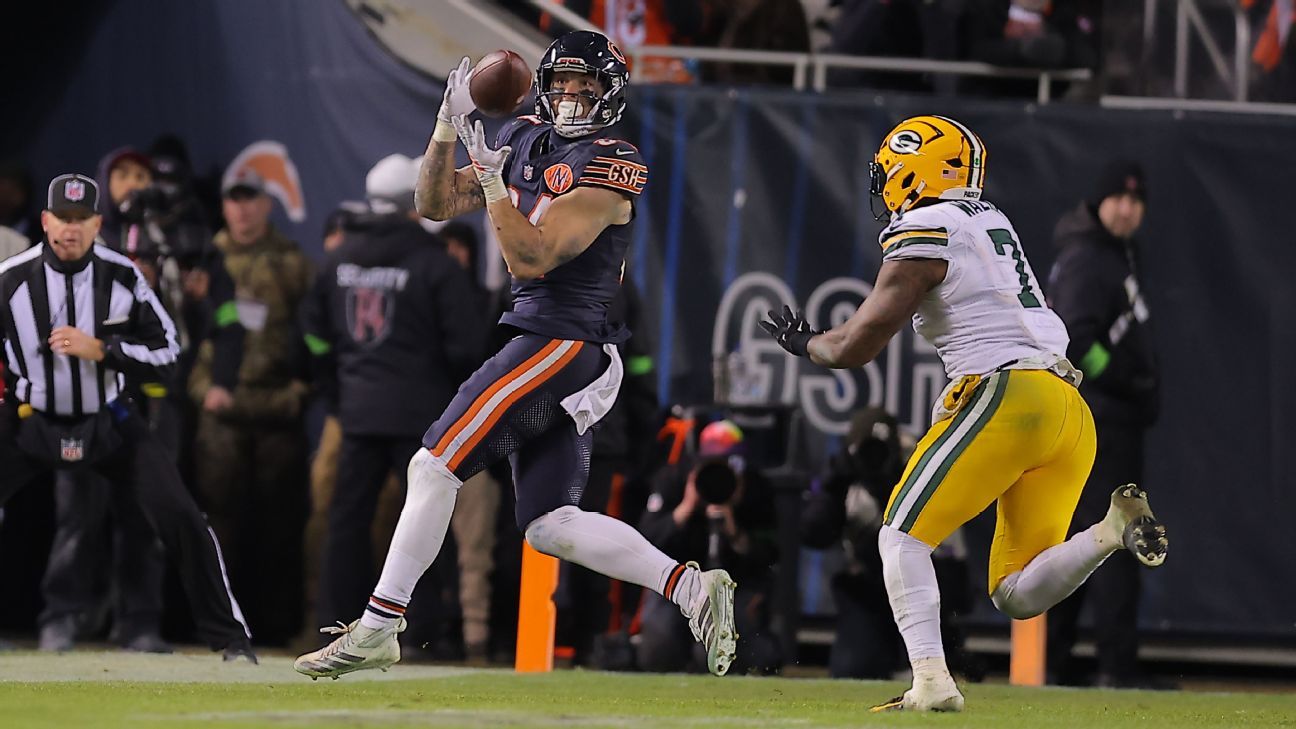Max Olson

Max Olson
ESPN Staff Writer
- Covers the Big 12
- Joined ESPN in 2012
- Graduate of the University of Nebraska
Eli Lederman

Eli Lederman
ESPN Staff Writer
- Eli Lederman covers college football and recruiting for ESPN.com. He joined ESPN in 2024 after covering the University of Oklahoma for Sellout Crowd and the Tulsa World.
Sep 17, 2025, 05:08 PM ET
UCLA and Virginia Tech kicked off the coaching carousel season in college football on Sunday when they moved on from DeShaun Foster and Brent Pry, respectively, after 0-3 starts.
Athletic directors generally don't want to make these dramatic changes and give up on a season in September, and they try not to unless the results are truly disastrous. In both cases, blowout home losses to Group of 5 opponents in Week 3 made delaying the inevitable untenable. Now it's up to interim coaches to try to salvage the rest of the season while coaching searches begin in earnest.
In this era of college football, though, the factors an athletic department must weigh firing before a head coach extend far beyond just the cost of the buyout. Players can now immediately enter the transfer portal. Recruits decommit as soon as they hear the news. Even the most high-profile vacancies require major roster rebuilds.
Here's a closer look at the fallout that programs now deal with when a head coach gets fired early in the season.

Can players enter the transfer portal now?
The head coaching changes at UCLA and Virginia Tech triggered a 30-day window for players to enter their names in the NCAA transfer portal and start exploring a move. There's no obligation to decide right now, as these players will still have the option to enter the portal after the season.
Virginia Tech cornerback Dante Lovett was the first to take advantage of this on Tuesday, putting his name in the portal after playing in three games in a reserve role for the Hokies this season. Coaches can now begin contacting and recruiting him to join their program in January. Technically, a player could enter their name in the portal and keep playing with their current team, but that's not something a coaching staff typically tolerates.
But can they actually play for a new team right away?
No. The NCAA does not allow players to compete for multiple teams in the same season. If a player enters the portal in September and chooses a school on the quarters system that can still get them enrolled this fall, they could start practicing with their new team but cannot play in a game. UCLA is one of the few Power 4 schools on the quarters system and doesn't start classes until Sept. 25.
What happens to NIL money if players leave midseason?
This is a new layer of complexity for players contemplating leaving their team during the season. This is the first year where players have entered into agreements directly with their school, rather than a third-party NIL collective. The language in revenue sharing agreements vary from conference to conference and school to school but can include clawback provisions to help schools recoup some money when players transfer out.
In April, Arkansas' NIL collective retained an attorney to try to enforce the buyout provisions in NIL agreements with two players, Madden Iamaleava and Dazmin James, who transferred. How enforceable these buyout provisions actually are remains to be seen, but players who want to transfer out right now must factor in these complications tied to their compensation.
What about redshirting?
In 2018, the NCAA amended its rules to give players an opportunity to play in four games during their redshirt year. Players can now also play in bowl games and the College Football Playoff without those postseason appearances counting towards the four-game limit. Ever since that rule changed in 2018, we've seen players who are unhappy with their roles announce four games into their season that they're going to redshirt and leave their team to pursue a transfer. Making a coaching change three games into the season is certainly going to motivate some players to consider that option if it's available to them.
Could an entire team jump in portal and redshirt?
No. Players can redshirt one season during their college career, so those who have already taken one can't opt out after four games and get this season back. The only exception are players who suffer season-ending injuries within their first four games. Those players can apply for medical redshirts and, if approved, get that year back. Sure, it's possible that a large group of players could opt out of the rest of the season, but there's not much incentive to do so if they have already redshirted in previous seasons.
What does history tell us about these moves?
The FBS programs that experience the most roster attrition are almost always the ones going through coaching changes. Purdue and Marshall both saw more than 50 scholarship players depart their programs this offseason during their transitions to new coaching regimes. Now that players are allowed to make unlimited transfers and coaches can sign as many as they want each year, there's more roster turnover across college football than ever before.
Last season, no Power 4 programs made a coaching change until North Carolina fired Mack Brown on Nov. 26. We did see 10 Group of 5 jobs open before then, starting in late October. At Kennesaw State, a total of 25 scholarship players entered their names in the portal within a week of Brian Bohannon's departure. Eleven of those players later withdrew from the portal and stayed in the program, but that many players exploring transfers in mid-November becomes a major challenge for whoever takes the job next.
In 2023, Michigan State fired Mel Tucker on Sept. 27 and had eight scholarship players enter the portal in October and November. Texas A&M moved on from Jimbo Fisher that year on Nov. 12 but only lost one before the season was over. Whether they officially go in the portal or not, players on these teams tend to quickly find out whether other schools are interested, especially now that more and more of them have agents.
What about high school recruits?
In short, it's open season. Schools were permitted for the first time to extend written revenue-sharing contracts to high school recruits on Aug. 1. By rule, however, those deals cannot be formally signed until the early signing period opens on Dec. 3. Even in instances where recruits are receiving early payments through state-to-state NIL laws, there's very little -- if anything at all -- that can bind a given high school prospect to a program before December.
Few recruitments are even fully closed until a prospect puts pen to paper. But an in-season coaching change offers committed prospects a clear path to fully reopen the process. At UCLA, seven members of the nation's 21st-ranked 2026 recruiting class decommitted in the 48 hours after Foster's exit. If questions have been swirling over a head coach's future -- as was the case at both UCLA and Virginia Tech -- there's a good chance recruits and their representatives have already been in touch with other programs for weeks by the time he's officially fired.
As of Sept. 17, all but three of the prospects inside the 2026 ESPN 300 hold a commitment. Included in that trio are offensive tackles Johnnie Jones and Thomas WIlder, who pulled their pledges from UCLA and Virginia Tech, respectively, hours after Foster and Pry were let go. Given the thin pool of elite uncommitted 2026 recruits, prospects returning to the open market -- especially at premium positions like quarterback and offensive tackle -- hold some leverage at this point in the cycle. Conversely, after many top programs expended the bulk of their revenue-share budgets for the 2026 class this summer, those same recruits may struggle to command the same dollar amounts they were previously set to earn with their former programs.
Will these schools move quickly to hire a head coach?
Probably not. By moving on from their head coaches in September, UCLA and Virginia Tech have given themselves a head start on the 2025 coaching carousel. From here, the pair of schools will be able to spend the coming weeks and months hiring search firms, gauging national interest in their openings and building a pool of candidates, all out in the open.
That's helpful. But hiring a sitting head coach or coordinator in-season -- particularly one doing well enough in another job to warrant consideration -- is exceedingly difficult. Texas Tech boldly tried to pull this off during the 2021 season, firing coach Matt Wells after a 5-3 start and pursuing UTSA's Jeff Traylor while his Roadrunners were 8-0. They ended up hiring Baylor assistant Joey McGuire, who left the Bears with three games left in the regular season to get a head start in Lubbock.
The 2022 coaching carousel started early with Nebraska, Arizona State, Georgia Tech, Colorado and Wisconsin all firing their coaches by the first week of October. In each instance, though, those programs didn't hire a successor until the end of the regular season. Unless these schools gravitate toward out-of-work candidates, it may not be until late November that either makes a hire.
Additionally, the openings at UCLA and Virginia Tech each feature major question marks surrounding future administrative leadership, available resources and broader university support for football. Any candidate with serious interest in either job will want answers on those unknowns, meaning UCLA and Virginia Tech must likely solve other problems first before identifying their next head coach.














































